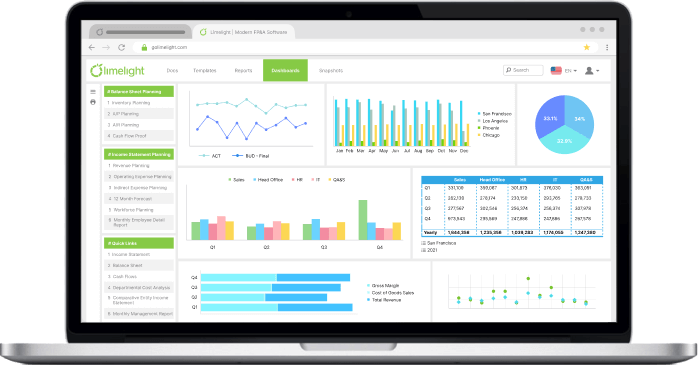Financial Planning & Analysis
SAP for Planning & Budgeting: Top 5 FP&A Integrations

By Jade Cole |
Published: April 15, 2025

By Jade Cole |
Published: April 15, 2025

SAP’s Native Budgeting ToolsSAP’s budgeting tools, like SAP Business Planning and Consolidation (BPC) and Business One, offer enterprise-grade budgeting and planning solutions. They streamline financial planning, improve compliance, and standardize processes.
However, as businesses demand greater agility, real-time insights, and faster decision-making, some may find SAP’s traditional structure less flexible for modern financial planning and analysis (FP&A) needs.
The challenge?
High costs, steep learning curves, and workflows can slow down rapid forecasting and budgeting adjustments.
Users on review sites like Gartner, Capterra, and Reddit have emphasized certain drawbacks of SAP BPC, particularly the lack of flexibility, complex workflows, and poor usability.
SAP budgeting and planning tool’s user review on Gartner peer insights
SAP budgeting and planning tool user review on Gartner peer insights
SAP BPC tool user review on Reddit
SAP budgeting and planning tool user review on Capterra
So, how can companies enhance their budgeting and forecasting capabilities without completely overhauling SAP?
FP&A integrations offer a solution. These tools work alongside SAP, providing advanced forecasting, real-time insights, and scenario modeling without the complexity.
Dive in to explore how SAP users can boost financial planning agility, and review our list of the top five FP&A integrations.
SAP offers budgeting capabilities through tools like SAP BPC and SAP Business One, catering to diverse organizational needs.
SAP BPC streamlines financial operations via a unified platform for planning, budgeting, forecasting, and consolidation. It helps organizations manage and analyze financial data efficiently, supporting better decision-making.
SAP BPC helps you create and manage various types of plans, including strategic and operational plans. Users can define different planning periods and scenarios, accommodating both short-term and long-term planning needs.
Planning in BPC can span multiple years and allows for various periodicities, such as weeks, months, quarters, or years. Its integration with Microsoft Excel and web-based tools, including HTML5 and SAP Analytics Cloud, enhances stakeholder engagement through improved visualization, leading to better planning outcomes.
SAP BPC offers tools for creating and managing budgets, enabling organizations to adjust strategies and improve financial outcomes. Its budgeting features support both top-down and bottom-up approaches, allowing for the creation of budgets based on predefined assumptions or targets.
You can compare budgeted figures with actual performance. It enables performing variance analysis to identify discrepancies and adjusting strategies. Further, the tool has Business Process Flows (BPFs). These are in-built workflows for financial processes, organizing input forms, reports, books, and dashboards.
SAP BPC enable users to predict future financial performance based on historical data and user-defined assumptions. Users can model and plan various what-if scenarios, build and quickly update forecast models, and compare current forecasts to previous periods. For example, in a May forecast, users can incorporate actual financial data from January to April and project future performance from May to December.
This feature allows the assessment of budget suitability in real time, facilitating quick course corrections and strategy adjustments to sudden or upcoming changes. Integration with SAP Analytics Cloud extends financial forecasting with advanced capabilities.
SAP BPC automates the financial statements aggregation from multiple entities into a single set, including capabilities like currency translation, intercompany eliminations, allocations, partial ownership, equity pick-up, and journals, while ensuring compliance with financial reporting standards.
The tool supports real-time consolidations with SAP S/4HANA and non-SAP ERP systems. It allows handling scenarios such as consolidating multiple general ledgers with varying charts of accounts.
SAP Business One's budgeting tool helps businesses manage and track expenses and revenues, providing financial forecasts. The system supports multiple budgeting scenarios, with a main budget scenario automatically created for each company. Additional scenarios can be defined for different planning needs.
SAP Business One’s native budgeting tool integrates with the General Ledger (GL) to facilitate financial planning and control. Once enabled, a main budget scenario is automatically set up for each company, and additional scenarios can be created as needed. For example, users might set up optimistic, pessimistic, or project-specific budgets.
Budgets are directly linked to specific GL accounts, allowing users to allocate amounts for different periods (e.g., months or quarters). The system also provides automated distribution methods—equal, ascending, or descending—to streamline allocation across periods.
A key feature is the ability to use historical GL data: users can copy budgets from previous years or base them on actual amounts from the GL. This ensures that budgets align with past performance, making financial planning more data-driven and realistic.
SAP Business One's GL integration extends to budget reporting and variance analysis. Users can generate reports comparing budgeted versus actual figures for each GL account.
The system also supports Excel integration. Users can export budget data for analysis and import updated figures back into SAP Business One.
When entering new transactions, the system automatically checks if they exceed the allocated budget for the associated GL account. Depending on your settings, it can either issue a warning or block the transaction, ensuring financial discipline and preventing over-spending in real-time.
Budget management in SAP Business One includes security features to protect data integrity. Access to budget settings and transactions is controlled through user roles and authorizations, ensuring that only authorized personnel can modify budgets or confirm deviations. The system also provides a complete audit trail. You can trace all budget-related activities for regulatory compliance and financial transparency.
Let’s explore the challenges and gaps in native SAP budgeting tools and why additional FP&A integrations might be needed.
BPC is a powerful SAP planning and budgeting solution, particularly for large enterprises. However, it comes with high costs, including licensing fees and the need for specialized expertise to implement and maintain.
Implementation costs can be substantial, covering licensing fees, hardware requirements for on-premise deployments, and SAP consultants. For example, SAP BPC requires technical expertise for tasks like customizing reports, which increases overall costs.
To manage these challenges, organizations can:
Customization within SAP budgeting tools can be challenging due to their structured design, which may not suit fast-growing companies requiring quick adaptations. While SAP BPC allows for some customization—such as UI themes and language localization—these adjustments often demand significant effort and technical expertise.
SAP offers customization options through logic scripts and business rules, allowing businesses to tailor processes to specific needs. However, implementing these features often requires ABAP programming or similar skills, which can be a barrier for many organizations.
To enhance flexibility, integrate with reliable third-party, cloud-based solutions, such as Limelight, to enhance budgeting and forecasting while maintaining agility and reducing the time and resources needed for extensive SAP customizations.
While SAP budgeting and planning tools like BPC offer some real-time capabilities, they may fall short in faster scenario planning and advanced forecasting, unless supplemented with additional systems.
BPC provides real-time data access when integrated with SAP S/4HANA, enabling planners to respond to organizational changes. However, for forecasting, the tool often relies on manual processes or basic what-if analyses, which may not suffice for modern business needs.
To address this:
Given these limitations, additional integrations are often necessary to fill the gaps in SAP’s native budgeting tools. Third-party solutions powered by automation and advanced capabilities offer flexibility and cost-effective customization, helping organizations maximize their SAP planning and budgeting investments while meeting modern financial management requirements.
The FP&A process starts with gathering accurate, comprehensive data. SAP users pull financial and operational data from SAP S/4HANA, SAP ERP, or external sources into SAP BPC or SAP Analytics Cloud. Automating this step with SAP’s integration capabilities ensures real-time data flows, reducing manual errors.
SAP BPC supports what-if scenario modeling, while SAP Analytics Cloud and third-party tools enable predictive forecasting. Users can model multiple outcomes—such as revenue shifts under different market conditions—quickly and efficiently.
In SAP BPC, users allocate resources across departments, using top-down or bottom-up approaches and distribute budgets across periods using predefined structures (e.g., equal or ascending allocations).
SAP BPC’s reporting tools and interactive FP&A dashboards provide real-time variance analysis, helping teams identify and correct financial deviations.
Limelight FP&A tool for SAP homepage
Limelight cloud FP&A is a leading SAP planning and budgeting tool with native integration with SAP S/4HANA, ensuring real-time data access for seamless planning and analysis. It offers advanced forecasting, customizable templates designed for SAP users, and a modern cloud-based interface for collaborative financial planning. Additionally, Limelight is the only FP&A platform that doesn’t run on Excel.
Benefits include:
Datarails FP&A solution integrations homepage
Datarails provides Excel-based financial analytics, integrating with SAP to automate data retrieval and reporting. Its key feature is a familiar Excel interface, supporting scenario planning and data validation. This benefits users who are comfortable with spreadsheets, offering flexibility in analysis. It’s ideal for organizations with existing Excel workflows.
Workday Adaptive Planning FP&A software homepage
Workday Adaptive Planning excels in enterprise planning, integrating with SAP via APIs for data connectivity. It offers robust tools for budgeting, forecasting, and scenario modeling, with dashboards for monitoring. Its strength lies in comprehensive planning across finance and HR, but SAP integration might require additional setup.
Anaplan FP&A solution homepage
Anaplan provides dynamic modeling for FP&A, integrating with SAP through connectors for data access. It features AI-powered insights, collaboration tools, and mobile access, benefiting organizations needing flexible planning. However, its SAP integration may not be as seamless as native solutions, impacting real-time data flow.
Cube offers a user-friendly, web-based interface for FP&A, integrating with SAP via APIs for data import. It supports scenario analysis, automated reporting, and collaboration and is ideal for teams seeking simplicity.
This table evaluates SAP native tools (e.g., SAP BPC, SAP Analytics Cloud) against FP&A integrations (e.g., Limelight).
|
Aspect |
SAP Native Tools |
FP&A Integrations |
|
Key Features |
|
|
|
Pros |
|
|
|
Cons |
|
|
|
Use-Case Scenarios |
|
|
To truly maximize SAP’s FP&A (Financial Planning and Analysis) capabilities beyond the basics, consider these advanced best practices that focus on leveraging the platform's full potential:
By focusing on these advanced best practices, you can harness the full power of SAP's FP&A capabilities and create a more agile, data-driven planning process. These strategies will help streamline operations, improve forecasting accuracy, and ultimately drive better decision-making at every level of your organization.
Here are expert recommendations to help you enhance your budgeting, forecasting, and planning using SAP and FP&A integrations.
Expert recommendations:
Use automated FP&A tools like Limelight for deeper insights. Integrating SAP tools with such modern, cloud-based analytics platforms helps uncover key growth drivers.
Expert recommendations:
User training boosts adoption of SAP tools and fosters cross-department collaboration for more aligned planning.
Expert recommendations:
Review budgets and forecasts monthly or quarterly to compare actuals against projections. Variance analysis helps identify areas requiring corrective action.
Expert recommendations:
Starting with SAP’s pre-built templates, customize dimensions, calculations, and workflows to fit your organization’s specific needs.
Expert recommendations:
Clear governance structures ensure role-based security, data integrity, and compliance with regulatory standards.
Expert recommendations:
Finance teams are under increasing pressure to move beyond traditional budgeting cycles toward continuous forecasting, respond swiftly to market shifts, and automate FP&A workflows—all while maintaining their existing tech stack.
SAP’s robust yet rigid structure often limits this agility, slowing response times and complicating automation for growing and mid-sized companies. These teams need flexible, user-friendly tools that provide faster scenario modeling with real-time data and serve as a cost-effective alternative to SAP’s hefty investment.
Limelight’s FP&A SAP integration complements or enhances SAP planning and budgeting, offering a modern, Excel-free platform that empowers finance teams with the agility, affordability, and functionalities they need to respond quickly to changing market conditions.
Book your personalized demo today to explore how Limelight’s FP&A SAP integration can optimize your SAP planning and budgeting processes.
Yes, SAP offers budgeting capabilities via SAP BPC and SAP Business One, but advanced planning may require additional FP&A integrations.
Yes, budgeting is a core component of FP&A, which also encompasses forecasting and analysis for strategic decision-making.
In SAP, budgeting defines the spending limits while planning forecasts the timing and nature of expenditures; the terms are often used interchangeably.
Yes, financial analysts frequently use SAP, particularly modules like SAP BPC (Business Planning and Consolidation), SAP Analytics Cloud, and SAP S/4HANA Finance. These tools help analysts with budgeting, forecasting, financial reporting, data analysis, and consolidation activities. SAP provides comprehensive financial analytics capabilities that enable analysts to extract insights from complex financial data and support informed business decisions.
SAP FI (Financial Accounting) is the core finance module, handling general ledger, accounts payable/receivable, and financial reporting. SAP CO (Controlling) manages cost accounting and internal reporting. For advanced capabilities, SAP S/4HANA Finance integrates these functions with real-time analytics. Additional modules include Treasury and Risk Management, Financial Supply Chain Management, and SAP Analytics Cloud for planning and budgeting.
SAP excels at integrating enterprise-wide business processes through its comprehensive ERP system. It's best for large and mid-sized organizations needing seamless data flow across departments, robust financial management, supply chain optimization, and advanced analytics. SAP's strength lies in standardizing operations, enforcing compliance, and providing real-time visibility into business performance, enabling data-driven decision-making across the organization.
Subscribe to our newsletter


